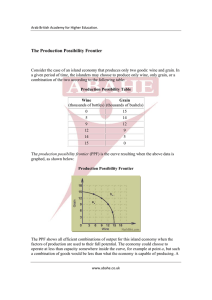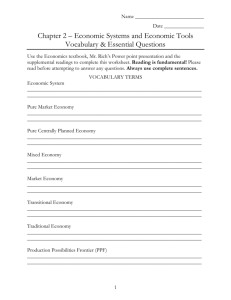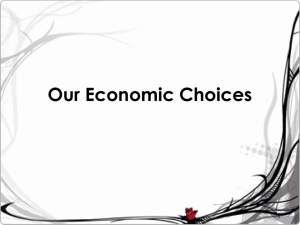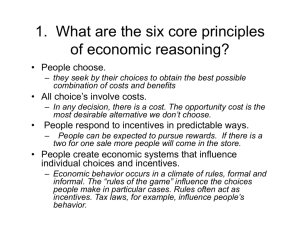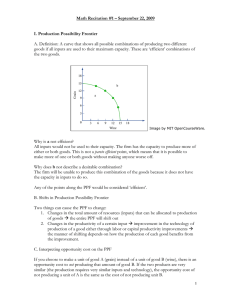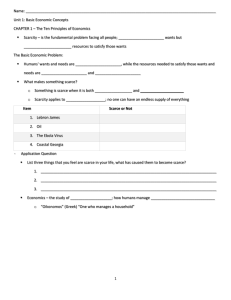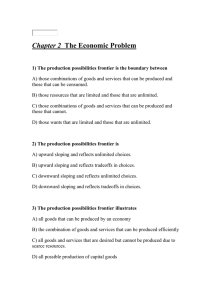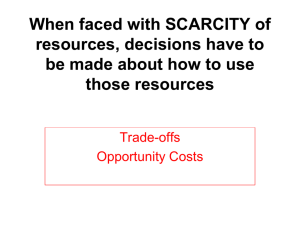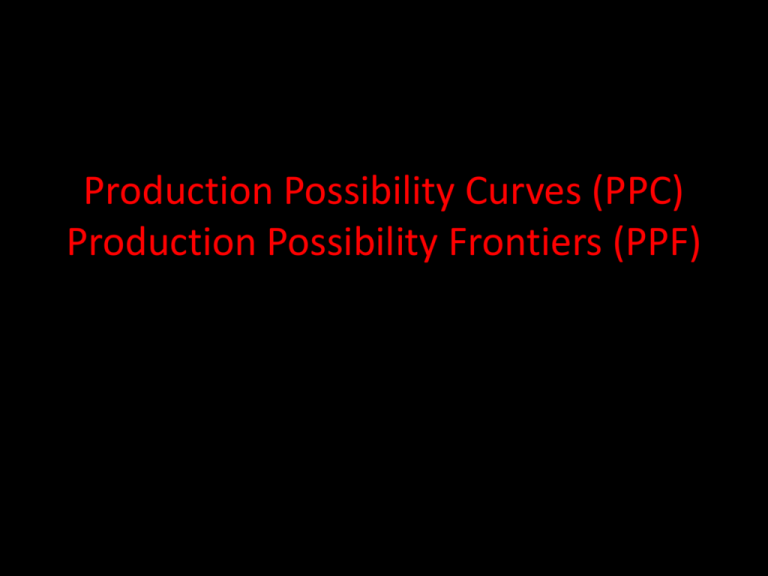
Production Possibility Curves (PPC)
Production Possibility Frontiers (PPF)
Consider the case of
an island economy
that produces only
two goods: wine and
grain.
In a given period of
time, the islanders
may choose to
produce only wine,
only grain, or a
combination of the
two according to the
following table:
Wine
(thousands of bottles)
Grain
(thousands of bushels)
0
15
5
14
9
12
12
9
14
5
15
0
Production Possibility Frontier
The PPF shows all efficient
combinations of output for this island
economy when the factors of
production are used to their full
potential.
The economy could choose to operate
at less than capacity somewhere inside
the curve, for example at point a, but
such a combination of goods would be
less than what the economy is capable
of producing.
A combination outside the curve such
as point b is not possible since the
output level would exceed the capacity
of the economy.
• The shape of this production possibility frontier
illustrates the principle of increasing cost.
• As more of one product is produced, increasingly
larger amounts of the other product must be
given up.
• In this example, some factors of production are
suited to producing both wine and grain, but as
the production of one of these commodities
increases, resources better suited to production
of the other must be diverted.
Experienced wine producers
are not necessarily efficient
grain producers, and grain
producers are not
necessarily efficient wine
producers, so the
opportunity cost increases
as one moves toward either
extreme on the curve of
production possibilities.
The slope of the line
represents the opportunity
cost of increasing the `X'
good by one unit.
For example, moving from
A to B means gaining 50
defense units, but
sacrificing 85 nondefense
units.
So the opportunity costs
of moving from A to B is 85
nondefense units.
This is what we have to
give up.
• Why does the production possibilities curve
bow outward? We have intentionally drawn
the curve this way to reflect the principle of
increasing costs.
• The Principle of Increasing Costs says that as
production of a good expands, the
opportunity cost of producing another unit
generally increases.
This is because resources tend to be specialized so that
some of their productivity is lost when they are
transferred from what they do well to what they do
poorly.
One can see in the chart above that the opportunity
cost of producing more and more defense goods
increases.
No Specialized Resources
• When resources are not specialized, the
principle of increasing costs does not apply
and the production possibilities frontier is a
straight line.
• This is represented in the chart below which
plots the production of right shoes versus left
shoes. Resources required to produce each of
these products are very similar.
Economic Growth
• Economic growth is the increase in the economy's level
of production. Recall that the production possibilities
frontier shows the possible production of two goods
given the available resources and technology.
• Economic growth can occur because either the
resource base expands, or the level of technology
increases.
• Economies grow when population grows because labor
is an important resource. The United States economy
grew from a population of about 5 million in 1800 to
over 90 million in 1900. This was a time of massive
resource growth in our nation's history.
• Economic growth also occurs when we learn
how to use our existing resources more
productively.
• This is what we call technological progress.
• For a given amount of resources, the
economy's level of output increases.
• In either case, economic growth results in a
shift outward of the production possibilities
frontier.
Sources
• Copyright © 2002-2007 NetMBA.com. All
rights reserved.
• http://sorrel.humboldt.edu/~economic/econ1
04/outline.htm

